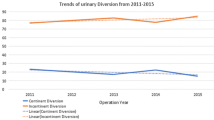Abstract
Objective
Quality-of-care indicators have not yet been defined for patients with bladder cancer. Nonetheless, certain aspects of bladder cancer care can be evaluated to quantify the quality of care delivered. We sought to determine trends in continent urinary diversion to evaluate the adoption of this more optimal reconstruction.
Methods
Subjects who underwent radical cystectomy for a primary diagnosis of bladder cancer were identified from the Healthcare Cost and Utilization Project Nationwide Inpatient Sample. We identified covariates independently associated with utilization of continent urinary diversion after radical cystectomy using multivariate logistic regression modeling. We then examined trends in diversion type based on patient and hospital characteristics and examined the impact of hospital volume on use of continent reconstruction.
Results
Our weighted sample included 5,075 subjects (14.3%) who underwent continent urinary diversion and 30,295 subjects (85.7%) who underwent an ileal conduit. Independent correlates of continent diversion included younger age, male gender, having private insurance, and undergoing surgery at an urban teaching hospital. Hospitals performing continent diversions on more than 40% of their cystectomies had a yearly cystectomy volume of 0.8 surgeries. Subjects treated at high-volume hospitals trended toward lower rates of comorbid conditions.
Conclusions
We identified substantial disparities in continent diversion which, based on yearly trends, are unlikely to improve in the near future. Continent reconstructions are not the exclusive domain of high-volume cystectomy centers. Yet efforts to increase rates of this complex reconstruction must concentrate on technique dissemination and better definition of the quality-of-life detriments incurred by cystectomy patients.

Similar content being viewed by others
References
Litwin MS (2000) Prostate cancer patient outcomes and choice of providers: development of an infrastructure for quality assessment. RAND, Santa Monica
Bellmunt J, Albiol S, Kataja V (2008) Invasive bladder cancer: ESMO clinical recommendations for diagnosis, treatment and follow-up. Ann Oncol 19(Suppl 2):ii47–ii48. doi:10.1093/annonc/mdn085
Montie JE, Abrahams NA, Bahnson RR et al (2006) Bladder cancer. Clinical guidelines in oncology. J Natl Compr Canc Netw 4:984–1014
Smith JA Jr, Labasky RF, Cockett AT et al (1999) Bladder cancer clinical guidelines panel summary report on the management of nonmuscle invasive bladder cancer (stages Ta, T1 and TIS). The American urological association. J Urol 162:1697–1701. doi:10.1016/S0022-5347(05)68208-0
Sternberg CN, Donat SM, Bellmunt J et al (2007) Chemotherapy for bladder cancer: treatment guidelines for neoadjuvant chemotherapy, bladder preservation, adjuvant chemotherapy, and metastatic cancer. Urology 69:62–79. doi:10.1016/j.urology.2006.10.041
Clark PE, Stein JP, Groshen SG et al (2005) Radical cystectomy in the elderly: comparison of clincal outcomes between younger and older patients. Cancer 104:36–43. doi:10.1002/cncr.21126
Stein JP (2000) Commentary urinary diversion and bladder substitution in patients with bladder cancer. Urol Oncol 5:232–233. doi:10.1016/S1078-1439(00)00096-X
Stein JP, Cote RJ, Freeman JA et al (1995) Indications for lower urinary tract reconstruction in women after cystectomy for bladder cancer: a pathological review of female cystectomy specimens. J Urol 154:1329–1333. doi:10.1016/S0022-5347(01)66850-2
Stein JP, Esrig D, Freeman JA et al (1998) Prospective pathologic analysis of female cystectomy specimens: risk factors for orthotopic diversion in women. Urology 51:951–955. doi:10.1016/S0090-4295(98)00099-5
Allareddy V, Kennedy J, West MM et al (2006) Quality of life in long-term survivors of bladder cancer. Cancer 106:2355–2362. doi:10.1002/cncr.21896
Bjerre BD, Johansen C, Steven K (1995) Health-related quality of life after cystectomy: bladder substitution compared with ileal conduit diversion. A questionnaire survey. Br J Urol 75:200–205
Boyd SD, Feinberg SM, Skinner DG et al (1987) Quality of life survey of urinary diversion patients: comparison of ileal conduits versus continent Kock ileal reservoirs. J Urol 138:1386–1389
Dutta SC, Chang SC, Coffey CS et al (2002) Health related quality of life assessment after radical cystectomy: comparison of ileal conduit with continent orthotopic neobladder. J Urol 168:164–167. doi:10.1016/S0022-5347(05)64853-7
Fujisawa M, Isotani S, Gotoh A et al (2000) Health-related quality of life with orthotopic neobladder versus ileal conduit according to the SF-36 survey. Urology 55:862–865. doi:10.1016/S0090-4295(00)00483-0
Gilbert SM, Wood DP, Dunn RL et al (2007) Measuring health-related quality of life outcomes in bladder cancer patients using the bladder cancer index (BCI). Cancer 109:1756–1762. doi:10.1002/cncr.22556
Hart S, Skinner EC, Meyerowitz BE et al (1999) Quality of life after radical cystectomy for bladder cancer in patients with an ileal conduit, cutaneous or urethral kock pouch. J Urol 162:77–81. doi:10.1097/00005392-199907000-00019
Hautmann RE, Abol-Enein H, Hafez K et al (2007) Urinary diversion. Urology 69:17–49. doi:10.1016/j.urology.2006.05.058
Porter MP, Penson DF (2005) Health related quality of life after radical cystectomy and urinary diversion for bladder cancer: a systematic review and critical analysis of the literature. J Urol 173:1318–1322. doi:10.1097/01.ju.0000149080.82697.65
Elixhauser A, Steiner C, Harris DR et al (1998) Comorbidity measures for use with administrative data. Med Care 36:8–27. doi:10.1097/00005650-199801000-00004
Gore JL, Saigal CS, Hanley JM et al (2006) Variations in reconstruction after radical cystectomy. Cancer 107:729–737. doi:10.1002/cncr.22058
Hollenbeck BK, Taub DA, Miller DC, et al (2004) Regionalization of radical cystectomy. J Urol 171:36 (abstract 137). doi:10.1097/01.ju.0000099680.27793.c5
Conflict of interest statement
None.
Author information
Authors and Affiliations
Consortia
Corresponding author
Rights and permissions
About this article
Cite this article
Gore, J.L., Litwin, M.S. & The Urologic Diseases in America Project. Quality of care in bladder cancer: trends in urinary diversion following radical cystectomy. World J Urol 27, 45–50 (2009). https://doi.org/10.1007/s00345-008-0348-y
Received:
Accepted:
Published:
Issue Date:
DOI: https://doi.org/10.1007/s00345-008-0348-y



